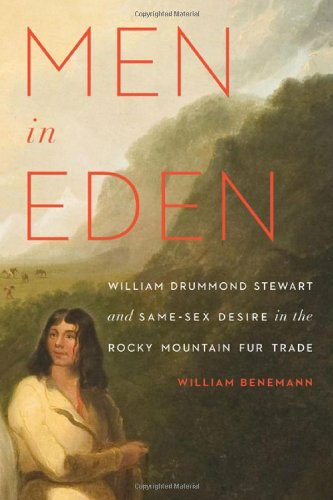 Men in Eden: William Drummond Stewart and Same-Sex Desire in the Rocky Mountain Fur Trade
Men in Eden: William Drummond Stewart and Same-Sex Desire in the Rocky Mountain Fur Trade
by William Benemann
Univ. of Nebraska Press. 343 pages, $29.95
WILLIAM DRUMMOND STEWART was part of the landed aristocracy in 19th-century Scotland, albeit a second son, who ultimately became baronet of Murthly Castle late in life upon the death of his childless older brother. With limited cash and not a lot to do prior to inheriting the title, he set out for “pleasure trips” to the Rocky Mountains, spending several years there as he had adventures and explored the beauty not only of the frontier landscape but also of the young, virile men who flocked to the Rockies to explore and escape as well.
For several years Stewart’s expeditions culminated in a bacchanal “rendezvous” of all the fur trade hunters, as well as their Native American counterparts, with feasts, drinking, sports competitions, and general male bonding (there were very few women among the parties). In Men in Eden, author William Benemann has woven a remarkable story—part Downton Abbey, part Edmund White’s States of Desire, and part Davy Crockett’s life on the frontier—painstakingly piecing together the swatches of Stewart’s life from primary source research. Stewart kept no journals of his adventures as such, but he wrote two “autobiographical novels” under a pseudonym, from which Benemann has extrapolated stories and life experiences.
There’s little doubt but that Stewart was a gay man, or a “fairy,” in Stewart’s preferred term. Early on in his American adventures he met famed Native American hunter Antoine Clement, and thus began an on-again, off-again relationship that spanned many years. Returning to Scotland for good following a mysterious scandal—the details remain unknown, but it probably involved indiscreet behavior of some kind—Stewart decorated Murthly Castle with artifacts of his American travels as well as paintings that he commissioned from Alfred Jacob Miller, who traveled with him to capture the essence of life on the frontier. Effectively exiled in the staid and proper Scottish countryside, Stewart lived out his remaining years surrounded by scenes of those grand times in the American West.
Benemann, who also wrote Male-Male Intimacy in Early America (2006), tells his story in an essentially linear, chronological order, with forays into several contextual chapters that give the reader a grounding in the social mores governing gender roles and male-male relationships in early 19th-century America. Those chapters take a little more plodding to get through, but the background they provide is fascinating. Benemann’s storytelling abilities are on display in this engaging and highly readable biography, which is also a worthy contribution to queer-focused early American history.
________________________________________________________
Christopher Lee Cochran is a librarian and writer based in Washington, D.C.






